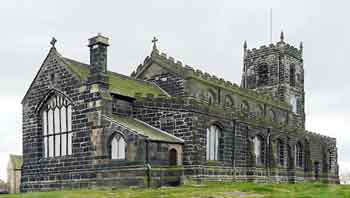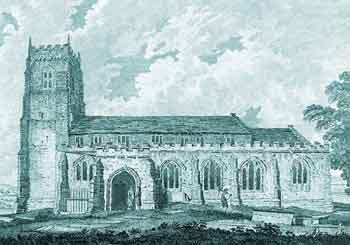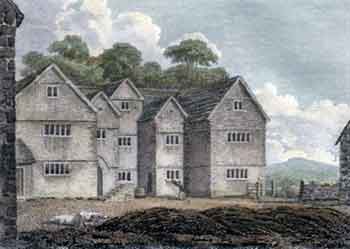

St Michael's Church.
 This church stands on an imposing position on Warhill overlooking Mottram in Longdendale.
The earliest evidence of a church on the site is in 1225 when the clergy witnessed local documents and another reference to the church is in a taxation document dated 1291.
However, the present church, built in the perpendicular style, dates from the end of the 15th century and externally it retains much of its Medieval character.
This church stands on an imposing position on Warhill overlooking Mottram in Longdendale.
The earliest evidence of a church on the site is in 1225 when the clergy witnessed local documents and another reference to the church is in a taxation document dated 1291.
However, the present church, built in the perpendicular style, dates from the end of the 15th century and externally it retains much of its Medieval character.
Sir Edmund Shaa (c.1427-20 Apr 1488), lived locally but rose to fame and fortune in London and became the Lord Mayor of London on the 13 Oct 1482. He left money for the building of the tower of St Michael’s Church and it is possible that the whole church was rebuilt at the same time, or maybe as an enlargement of the earlier church.
In Mar 1994 a blue plaque was unveiled on Church Brow, Mottram in Longdendale, by Tameside Metropolitan Borough to commemorate Sir Edmund Shaa.

In 1852 it was agreed that the church needed restoration work and in 1853 Edwin Hugh Shellard of Manchester was appointed as the architect. The work included taking down the clerestory and roof from the side aisles, leaving only the outer walls and chancel standing. Nevertheless, Edwin Hugh Shellard was replaced by John Edgar Gregan of Manchester as architect and the contractors were Eaton & Hollas (John Eaton & Joseph Hollas) of Ashton-under-Lyne. The work was carried out between 1854 and 1856 and the church was reconsecrated on the 25 Jun 1856 by the Rt Revd John Graham, Bishop of Chester.
The church is listed Grade II*, List Entry No. 1356436.

Sir Ralph Staveley (or de Staveleigh) and his wife, Lady Elizabeth Staveley
The Staveley Chapel of St Michael’s Church contains two sandstone effigies, which are believed to be those of Sir Ralph Staveley (c.1362-c.1420) and his wife, Lady Elizabeth Staveley, dating from the early 15th century.
The two effigies, in all likelihood, represent the knight and his wife and these were originally placed against the south wall of the church.

Sir Ralph Staveley was Lord of the Manor of Staley Hall, Stalybridge. The hall dates back to at least the early 15th century but the earliest records of the de Staveleigh family as Lords of the Manor of Staley date from the early 13th century. Staley Hall was the family residence and it is referred to in the diaries of Sir Ralph Staveley in the early 15th century. The hall was originally timber framed but it was stone-clad in the 17th century.
The hall, which is situated off Huddersfield Rd, Millbrook, Stalybridge, ultimately became derelict but in 2009 permission was granted for a housing development that included the restoration of the hall.
Staley Hall and adjoining West Wing are listed Grade II*, List Entry No. 1163021.
